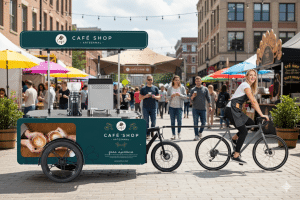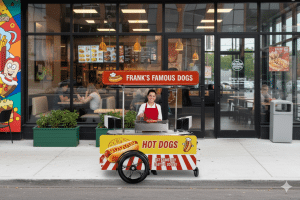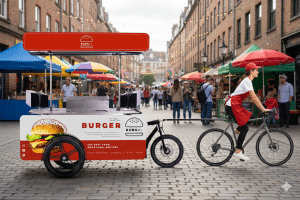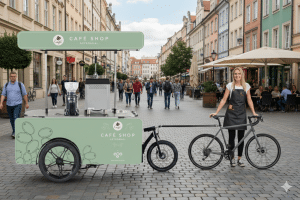Launching a street-food business today is faster, more flexible, and more efficient than opening a fixed outlet. With the right mobile format—food bike or food cart—you have the potential to pilot a concept, build a brand, and scale to multiple units with lower risk. Formats, niches and budgets and ROI, equipment and HACCP, licenses and hygiene basics (EU context), locations, branding, and a step-by-step roadmap to first revenue are all covered in this guide.

Street food is no longer just snacks at events. It’s a mobile ecosystem across coffee, gelato, fresh juices, gourmet sandwiches, and hot foods—often facilitated by small carts and bicycles that thrive in high-footfall areas (corporate campuses, events, malls, tourist spots). The category is supported by consumers seeking convenience plus “experience,” decent social media discovery, and low CAPEX relative to traditional storefronts. Recent industry research suggests the food-truck/mobile segment is still expanding globally (low-to-mid CAGR single-digit), with Europe boasting a top-tier regional share—testament to a vibrant street-food culture and condensed event calendar.
Sustainability advantage. Bike-towable units can cut operating emissions drastically versus van-based vending: cycling is consistently cited as one of the lowest-emission transport modes per km, and converting urban trips from cars to cycles provides high CO₂ savings—worth it for brand story, tenders, and ESG-oriented partners.
2) Mobile formats at a glance:
Food Carts

Compact, space-saving footprints that fit through doors and lifts; usable as push carts inside buildings or bike-towed outside. Ideal for coffee, gelato, fresh juices, and light hot foods. With the right power and water modules, carts handle complete HACCP workflows within surprisingly small footprints.
Food Bikes

Ultra-mobile brand billboards that shine where cars can’t go (historic districts, parks, campuses). Perfect for grab-and-go (coffee/espresso, soft serve, lemonade) and activations. Pair with a cart or trailer for back-of-house storage as needed.
Bizz On Wheels configurations: We build three cart sizes—M, L, XL—and every model can be used as a push cart or bicycle-towed with our proprietary draw-bar with motorcycle-grade wheel and hydraulic braking for stability and safe stopping under load. This gives you one platform that will work in indoor malls this week and outdoor festivals the next, with no hardware modifications.
3) Pick your niche (so your unit pays for itself)
Start with a tight, operationally simple menu you can execute consistently during peak seasons:
Menu design tips
4) Budget, recurring expenses & a simple ROI model
While exact numbers vary by country and spec, mobile units tend to require a fraction of the CAPEX of a shop fit-out. A cart or bike can often break even at a few dozen transactions per day at average European price points, depending on venue fees and labor.
A simple way to sanity-check ROI
Tip: Bike-towed carts save fuel/parking expenses and align with green procurement requirements in tenders (corporate campuses, municipalities). Mention cycling-emissions benefits in your proposals.

5) Equipment & HACCP: constructing a safe, efficient micro-kitchen
All over the EU, food establishments must follow general rules of hygiene and implement procedures founded on HACCP (Hazard Analysis and Critical Control Points). In practice, that will mean you must design your process (from receipt to service), control temperatures and cross-contamination risks, and record what you do. The law is Regulation (EC) No 852/2004; national authorities publish practical guides and checklists.
HACCP in one page (the 7 principles):
Your cart/bike equipment plan (by niche)
Basic hygiene facilities (minimum expectations in EU guidelines):
Bizz On Wheels engineering note: our M/L/XL carts are designed to accommodate hand-wash modules, water management, refrigeration, and power options. The motorcycle-wheel + hydraulic-brake tow system improves stability under load and irons out curbs and cobblestones—useful when transporting water, ice, or frozen stock between service points.
6) Licenses, notifications & compliance (EU context)
You’ll typically need to register/notify your food business with the local competent authority, implement procedures based on HACCP, and comply with premises and equipment hygiene requirements (surfaces, washing facilities, ventilation, lighting, drainage). Exact steps and documents vary by country and municipality (street trading permits, market/event permissions, private-site agreements). Start from the EU hygiene framework and then check national/local guidance for mobile units.
Practical checklist (non-legal guidance):
✅ Business registration/notification with local authority.
✅ Food-safety management (HACCP-based) documented; staff training records.
✅ Hand-wash facility; adequate ware-washing; safe water storage and disposal.
✅ Temperature control (cooling/freezing/holding) with logs.
✅ All contact surfaces food-grade and cleanable; allergen labeling where appropriate.
✅ Electrical/gas safety where used; fire safety kit; secure LPG if applicable.
✅ Waste contract; grey-water disposal plan; site permissions/permits for each location.
✅ Insurance (public liability), and if towing, local traffic/parking compliance.
Where to read more: EU Regulation 852/2004 (food hygiene) and national regulator packs such as the UK “Safer Food, Better Business” series, which include practical checklists applicable to small caterers and mobile operations.
7) Location strategy: where carts and bikes win
– High-footfall, low-friction: commuter flows, campuses, business parks, waterfronts, promenades.
– Inside malls & transit hubs: carts work well where trailers can’t go (elevators, narrow corridors).
– Events & festivals: anticipatable surges—prepare mise en place and pre-batch drinks.
– Corporate & private functions: branded pop-ups, product launches, weddings; premium pricing.
– Sporting events: football stadiums, world championships, tennis, formula 1, rally, etc.
Bike-tow benefit: rapid redeployments within the same neighborhood; access to pedestrianized areas; environmental credentials for RFPs and corporate CSR events.
8) Branding, menu engineering & content that sells
– Signature SKU + visual hook. Something people take a photo of and share (e.g., a distinctive cone or a hero espresso tonic).
– Condensed menu with premium add-ons. Price anchoring (small/regular/large), bundles (pastry + beverage), seasonal LTOs.
– Visual identity in motion. Your cart is a moving billboard: clean lines, bright colors, impeccable lighting; make the workspace Instagram-worthy.
– Short-form video pipeline. Reels/TikTok of scooping, sizzling, or pours; encourage UGC.
– Trust signals. Hygiene rating (where applicable), allergen transparency, sustainability claims (bike-tow, recyclable packaging) with concise, modest language.
9) A rough operating plan (day 0 to day 90)
Day 0–14: Foundations
Day 15–30: Prototype & supply
Day 31–60: Soft launch & learn
Day 61–90: Lock operations & scale
10) Illustrative mini P&L (coffee cart, weekday scenario)
Assumptions (example only—adapt to local prices):
11) Case study (composite): from initial cart to multi-unit
A founder begins with a Bizz On Wheels L cart as a push cart in a mall coffee pitch.
After validating demand and mastering 75–100 beverages/hour at peak, they incorporate bike-tow functionality for weekend markets. The hydraulic brake + motorcycle wheel stabilizes the tow even with refrigeration and water tanks on board. By month 4, they add a second unit—a towed M cart modified for lemonades/juices for outdoor activation—and cross-promote both menus. The brand books corporate event engagements based on low-emissions bike towing and space-efficient indoor setups. By month 9, the company runs three days mall + two days events, averaging higher weekend ARPU and pipeline for a future XL hot-snacks cart.
12) FAQ (for rich results & quick wins)
Do I need a HACCP plan for a food bike/cart?
Yes. EU law requires food businesses to have HACCP-based controls. The majority of national authorities have produced simplified packs for small/mobile operators.
What are the hygiene facilities needed?
You can expect a separate hand-wash basin with running water, adequate ware-washing, temperature control, and cleanable food-grade surfaces. Check your local authority’s specific interpretation for mobile units.
Where do food bikes and carts perform well?
High pedestrian areas, low-set-up settings: malls, commuter routes, events, campuses, private/corporate bookings.
How do I choose cart size (M/L/XL)?
Balance throughput + storage against your menu. M Carts is good for small menus or compact indoor spaces; L cart is a compromise between capacity and maneuverability; XL Cart provides more volume or hot-food additions. All Bizz On Wheels carts can be walked or bike-towed on the same platform.
13) Your next steps
* Choose your format & size (M/L/XL) and niche.
* Map out your HACCP (receiving → service → cleaning) and gather required documentation.
* Design the station for 60–90-second ticket times; select power/water modules.
* Lock in locations (pilot 2–3), and book an event calendar.
* Launch, measure, iterate, and expand—add units where demand clusters.
WhatsApp us